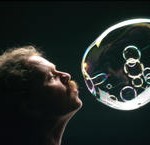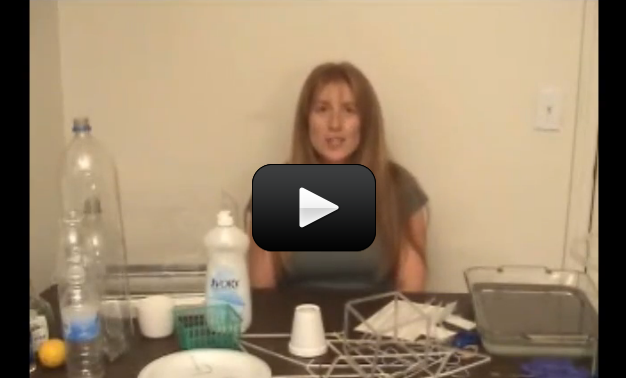
If you’re fascinated by the simple complexity of the standard soap bubble, then this is the lab for you. You can easily transform these ideas into a block-party Bubble Festival, or just have extra fun in the nightly bathtub. Either way, your kids will not only learn about the science of water, molecules, and surface tension, they’ll also leave this lab cleaner than they started (which is highly unusually for science experiments!)
Soap also makes water stretchy. If you’ve ever tried making bubbles with your mouth just using spit, you know that you can’t get the larger, fist-sized spit bubbles to form completely and detach to float away in the air. Spit is 94% water, and water by itself has too much surface tension, too many forces holding the molecules together. When you add soap to it, they relax a bit and stretch out. Soap makes water stretch and form into a bubble.
[am4show have=’p8;p9;p11;p38;p92;p80;p101;’ guest_error=’Guest error message’ user_error=’User error message’ ]
Download Student Worksheet & Exercises
The absolute best time to make gigantic bubbles is on an overcast day, right after it rains. Bubbles have a thin cell wall that evaporates quickly in direct sun, especially on a low-humidity day. If you live in a dry area with low-humidity, be sure to use glycerin. The glycerin will add moisture and deter the rapid thinning of the bubble’s cell wall (which cause bubbles to tear and pop).
Best Bubble Solution Gently mix together 6 cups cold water in a shallow tub with 1 cup green Dawn (or clear Ivory) dish soap. If it’s a hot, dry day, add a few tablespoons of glycerin. (Glycerin can be found at the drugstore.) If you’re finding the solution too thin, add a second cup of dish soap. You can add all sorts of things to find the perfect soap solution: lemon juice, sugar, corn syrup, Karo syrup, maple syrup, glycerin — to name just a few. Each will add its own properties to the bubble solution. (You can have buckets of each variation along with plain dish soap and water to compare.) You can reduce the water, increase the soap, etc… but here’s a good starting point: 2 cups dish soap with 1 cup Karo syrup and 6 cups cold water.
Zillions of Tiny Bubbles can be made with strawberry baskets. Simply dip the basket into the bubble solution and twirl around. You can also use plastic six-pack soda can holders.
Trumpet Bubbles are created by using a modified water bottle. Cut off the bottom of the bottle, dip the large end in the soap solution, put the small end to your lips, and blow. You can separate the bubble from the trumpet by rolling the large end up and away from your bubble.
Bubble Castles are built with a straw and a plate. First, spread bubble solution all over a smooth surface (such as a clean cookie sheet, plate, or tabletop). Dip one end of a straw in the bubble solution and blow bubbles all over the surface. Make larger domes with smaller ones inside. Notice how the bubbles change shape and size when they connect with others.
Stretch and Squish! Get one hand-sized bubble in each hand. Slap them together (so they join, not pop!). What if you join them s l o w l y?
Light Show is always a favorite. Find a dark room. Find a BIG flashlight and stand it on end. Rub soap solution all over the bottom of an uncolored plastic lid (such as from a coffee can). Balance the lid, soapy side up, on the flashlight (or on the spring-type clothespins). Blow a hemisphere bubble on top of the lid. Blow gently along the side of the bubble. Watch the colors swirl.
Weird Shapes are the simplest way to show how soap makes water stretchy. Dip a rubber band completely in the soap solution and pull it up. Stretch the rubber band using your fingers. Twist and tweak into all sorts of shapes. Note that the bubble always finds a way of filling the shape with the minimum amount of surface area. Make a Moebius bubble by cutting a thick ribbon, giving one end a half-twist, and reattaching the ends (by sewing, stapling, or taping).
Polygon Shapes allow you to make square and tetrahedral bubbles. Create different 3-D shapes by bending pipe cleaners into cubes, tetrahedrons, or whatever you wish. Alternatively, you can use straws threaded onto string to make 3-D triangular shapes. Notice how the film always finds its minimum surface area. Can you make square bubbles?
Gigantic Bubbles Using the straws and string, thread two straws on three feet of string and tie off. Grasp one straw in each hand and dip in soap solution. Use a gentle wind as you walk to make BIG bubbles. Find air thermals (warm pockets of air) to take your bubbles up, up, UP!
Kid-in-a-Bubble Pour your best bubble solution into a child’s plastic swimming pool. Lay a Hula-hoop down, making sure there is enough bubble solution to just cover the hoop. Have your child stand in the pool (use a stool if you want to avoid wet feet), and lift the hoop! For a more permanent project, use an old car tire sliced in half lengthwise (the hard way) to hold the bubble solution. The kid stands in the hole and doesn’t get wet!
Electric Bubbles Blow some fist-sized bubbles and set them loose. Rub an inflated balloon on your head or wool sweater to charge the balloon and get the charged balloon close to a soap bubble. If you are fast and careful enough, you can steer the bubble around the room.
Hover Bubbles Since bubbles are light, you can float them on a gas that is slightly denser than the air they are filled with, such as carbon dioxide. Place a shallow glass dish inside a larger glass dish or tank (like an unoccupied aquarium). Into the smaller dish, add two cups vinegar and one cup baking soda.
After the fizzing has subsided, your larger container is now filled with carbon dioxide gas. Make sure it’s away from drafts or movement so the invisible carbon dioxide gas stays in there. Gently blow bubbles near the opening so they settle into the large tank. (Don’t blow directly into the container, or you’ll slosh out the CO2.) Your bubbles will hover in the tank so you can have a closer look. What colors do you see? Do the colors change? Does the bubble stay in one place, rise, sink, or move around? If your bubble stays in the tank without popping, you’ll notice that it slowly becomes larger!
Mammoth Bubbles To create bubbles the size of a small car, use your lace trim. Knot the ends together to form a large loop, and dip your lace into the bubble solution. Gently pick up the loop with your hands about two feet apart, the rest dangling below. You should see a thin bubble film in the loop. Keep your hands spread apart and walk (keeping the bottom loop above the ground), and a bubble will form behind you. When it’s big enough, close the loop by bringing your hands together to seal off the bubble. You can also spin slowly in a circle to put yourself inside a “bubble-bagel” (mathematical term for this shape: toroid). If you do this in a place with warm updrafts (like next to a building), your bubbles will float up and away and quite possibly attract a small crowd… like the photo below.
The How and Why Explanation If you pour a few droplets of water onto a sweater or fabric, you’ll notice that the water will just sit there on the surface in a ball (or oval, if the drop is large enough). If you touch the ball of water with a soapy finger, the ball disappears into the fibers of the fabric! What happened?
Soap makes water “wetter” by breaking down the water’s surface tension by about two-thirds. Surface tension is the force that keeps the water droplet in a sphere shape. It’s the reason you can fill a cup of water past the brim without it spilling over. Without soap, water can’t get into the fibers of your clothes to get them clean. That’s why you need soap in the washing machine.
Soap also makes water stretchy. If you’ve ever tried making bubbles with your mouth just using spit, you know that you can’t get the larger, fist-sized spit bubbles to form completely and detach to float away in the air. Spit is 94% water, and water by itself has too much surface tension, too many forces holding the molecules together. When you add soap to it, they relax a bit and stretch out. Soap makes water stretch and form into a bubble.
The soap molecule looks a lot like a snake; it’s a long chain that has two very different ends. The head of the snake loves water, and the tail loves dirt. When the soap molecule finds a dirt particle, it wraps its tail around the dirt and holds it.
The different colors of a soap bubble come from how the white light bounces off the bubble into your eye. Some of the light bounces off the top surface of the bubble and bends only a little bit, while the rest passes through the thin film and bounces off the inner surface of the bubble and refracts more.
If you made the Hover Bubbles, you’ll notice that the bubbles slowly get larger the longer they live in the tank. Remember that the bubble is surrounded by CO2 gas as it sinks. The bubble grows because carbon dioxide seeps through the bubble film faster than the air seeps out, as CO2 is more soluble in water than air (meaning that CO2 mixes more easily with water than air does).
[/am4show]


I LOVE Trumpet Bubbles!!!!!!!
Okay!
Are you asking what kind of soap you can use and if it matters? Dish soap works great, like dawn or palmolive. Something thick and concentrated will work fine.
What cines of soaps can you use? Duse it matter?
Yes – it works fine!
Can you use blue dawn?
This is one of the very few experiments that doesn’t have an instructional video (the bubbles did not show up well on video when we tried!)
And also where are the videos.
once i held a puffer fish at a beach
I apologize for the confusion! You can request any grade level to be unlocked completely, I will have Tanya connect with you personally.